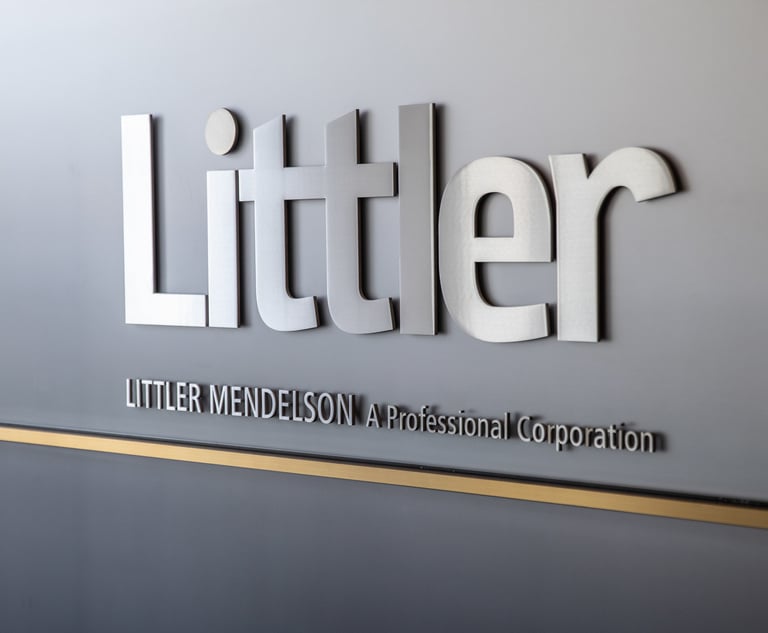Will a New 'Standard' to Describe Legal Work Help Innovation Thrive?
An ambitious group of law firms, clients and legal tech firms are developing a new language to measure value in the legal services market.
February 05, 2019 at 03:06 PM
6 minute read
 Photo: Africa Studio/Shutterstock.com
Photo: Africa Studio/Shutterstock.com
Time is an easy thing to communicate, and maybe that's why law firms and clients have for decades relied on the billable hour as the basis of their transactions.
Now, an ambitious group of prominent law departments, law firms and legal tech companies wants to help the legal industry adopt a new language that will encourage law firms and clients to evaluate the value of legal services beyond the billable hour—and to better understand what all that time is actually spent doing and what it accomplishes.
The Standards Advancement for the Legal Industry (SALI) Alliance last week published an initial set of codes that it hopes will ultimately serve as a new language to describe legal matters. That standard language, the group says, will allow clients to compare how law firms performed on similar types of matters and, in turn, help foster more value-based competition and innovation in the legal market. It will also help law firms better understand the costs they've historically incurred for certain types of work.
“The idea is to have a standard way to label, categorize and describe legal matters so we can better share information of what we're buying and selling,” said James Hannigan, senior manager of product development and project management at a California-based law firm, Allen Matkins Leck Gamble Mallory & Natsis, and a leading member of the SALI Alliance. “And that will allow us to do things like analytics better because we all will agree on what that work was.”
The benefits of a widespread, standard language to describe legal work, advocates say, include a better way for clients to compare law firms' experience on specific types of matters; to serve as a baseline for law firms to increase their efficiency on those matters; and to help law firms find and track documents or other work product from similar types of matters.
But developing that language is not an easy task, nor is it guaranteed to proliferate throughout the market. Critics of the idea may argue that some legal work is too nuanced to be classified in a routine, standardized way.
Responding to that criticism, Toby Brown, chief practice management officer at Perkins Coie who has been heavily involved in the SALI Alliance, said lawyers and law firms will be able to “extend” the standards to fit their own nuances. But Brown also said firms that classify their work in a nuanced manner will lose the ability to compare their work against the broader market, which he thinks will benefit firms in the long-run.
“In some respects, it's a cost-benefit decision they can make,” Brown said.
The group's members include corporations such as GlaxoSmithKline Plc, Microsoft Corp. and Royal Dutch Shell Plc; law firms such as Greenberg Traurig, Holland & Knight, Perkins Coie and Allen Matkins; and technology providers Bloomberg Law, LexisNexis, Prosperoware and Intapp, among others.
One difficulty in a creating a common description of legal work is that matters change over time. A regulatory inquiry may become a lawsuit; a transaction might include regulatory advice. The new standard is designed to track those types of changes, but it will still require administrative work on the part of law firms and clients to track, which many say has thwarted the effectiveness of the industry's existing task code systems.
The SALI standard is not intended to replace today's task code systems, which track things like taking depositions or drafting memos. Instead, those task codes would be linked to the matter descriptions that SALI is creating as a way to track the tasks and number of hours that are spent on a given matter.
“If there is any good thing about the billable hour it is that everybody agrees what an hour is: It's 60 minutes,” said Mark Medice, a principal at consulting firm LawVision Group who is working on the SALI standard. “What people can't agree on right now is, if time is not the focus of how we attribute value to something, what is the language that everybody in the industry can utilize to understand what value is?”
'Common Language'
The codes SALI released last week describe 27 areas of law, including practices like banking, transportation, intellectual property and personal injury. They also include subcategories for the practice areas. The environmental area of law, for instance, includes subcategories of mining, air, water, cleanup, waste/remediation and marine and ocean.
The release also includes five categories of what SALI calls “processes or services.” They include advisory, disputes, regulatory, bankruptcy and transactions. Those processes are also broken down into smaller categories, with disputes including nine discrete events like litigation in small claims court or civil court proceeding. The transactions process line is broken down into 17 categories, including things like financing, leases, mortgages and joint ventures.
One example SALI provided of a more complete description of a specific matter was for a labor and employment class action dispute based in New York. It might ultimately be coded as: “LEM-EMP/D-CCD(CLA)/USA-NY-NY.”
Toby Brown, a chief practice management officer at Perkins Coie who has been a leading figure in the standards body, said the draft standards released last week will now be used internally by at least two corporate legal departments as a test use case. The names of those companies have not yet been disclosed. The SALI Alliance hopes to release more aspects of the standard at a Legal Marketing Association conference in Chicago in June.
“We see that innovation is a bit stymied in the legal industry when we don't even have a common language around what law firms sell to clients,” Brown said. “This will allow firms to look at specific matter types and see what is happening in the market versus internally. We just can't do that now because there's no common language.”
This content has been archived. It is available through our partners, LexisNexis® and Bloomberg Law.
To view this content, please continue to their sites.
Not a Lexis Subscriber?
Subscribe Now
Not a Bloomberg Law Subscriber?
Subscribe Now
NOT FOR REPRINT
© 2025 ALM Global, LLC, All Rights Reserved. Request academic re-use from www.copyright.com. All other uses, submit a request to [email protected]. For more information visit Asset & Logo Licensing.
You Might Like
View All

Three Akin Sports Lawyers Jump to Employment Firm Littler Mendelson

Brownstein Adds Former Interior Secretary, Offering 'Strategic Counsel' During New Trump Term
2 minute read
Trending Stories
- 1Departing Attorneys Sue Their Former Law Firm
- 2Pa. High Court: Concrete Proof Not Needed to Weigh Grounds for Preliminary Injunction Order
- 3'Something Else Is Coming': DOGE Established, but With Limited Scope
- 4Polsinelli Picks Up Corporate Health Care Partner From Greenberg Traurig in LA
- 5Kirkland Lands in Phila., but Rate Pressure May Limit the High-Flying Firm's Growth Prospects
Who Got The Work
J. Brugh Lower of Gibbons has entered an appearance for industrial equipment supplier Devco Corporation in a pending trademark infringement lawsuit. The suit, accusing the defendant of selling knock-off Graco products, was filed Dec. 18 in New Jersey District Court by Rivkin Radler on behalf of Graco Inc. and Graco Minnesota. The case, assigned to U.S. District Judge Zahid N. Quraishi, is 3:24-cv-11294, Graco Inc. et al v. Devco Corporation.
Who Got The Work
Rebecca Maller-Stein and Kent A. Yalowitz of Arnold & Porter Kaye Scholer have entered their appearances for Hanaco Venture Capital and its executives, Lior Prosor and David Frankel, in a pending securities lawsuit. The action, filed on Dec. 24 in New York Southern District Court by Zell, Aron & Co. on behalf of Goldeneye Advisors, accuses the defendants of negligently and fraudulently managing the plaintiff's $1 million investment. The case, assigned to U.S. District Judge Vernon S. Broderick, is 1:24-cv-09918, Goldeneye Advisors, LLC v. Hanaco Venture Capital, Ltd. et al.
Who Got The Work
Attorneys from A&O Shearman has stepped in as defense counsel for Toronto-Dominion Bank and other defendants in a pending securities class action. The suit, filed Dec. 11 in New York Southern District Court by Bleichmar Fonti & Auld, accuses the defendants of concealing the bank's 'pervasive' deficiencies in regards to its compliance with the Bank Secrecy Act and the quality of its anti-money laundering controls. The case, assigned to U.S. District Judge Arun Subramanian, is 1:24-cv-09445, Gonzalez v. The Toronto-Dominion Bank et al.
Who Got The Work
Crown Castle International, a Pennsylvania company providing shared communications infrastructure, has turned to Luke D. Wolf of Gordon Rees Scully Mansukhani to fend off a pending breach-of-contract lawsuit. The court action, filed Nov. 25 in Michigan Eastern District Court by Hooper Hathaway PC on behalf of The Town Residences LLC, accuses Crown Castle of failing to transfer approximately $30,000 in utility payments from T-Mobile in breach of a roof-top lease and assignment agreement. The case, assigned to U.S. District Judge Susan K. Declercq, is 2:24-cv-13131, The Town Residences LLC v. T-Mobile US, Inc. et al.
Who Got The Work
Wilfred P. Coronato and Daniel M. Schwartz of McCarter & English have stepped in as defense counsel to Electrolux Home Products Inc. in a pending product liability lawsuit. The court action, filed Nov. 26 in New York Eastern District Court by Poulos Lopiccolo PC and Nagel Rice LLP on behalf of David Stern, alleges that the defendant's refrigerators’ drawers and shelving repeatedly break and fall apart within months after purchase. The case, assigned to U.S. District Judge Joan M. Azrack, is 2:24-cv-08204, Stern v. Electrolux Home Products, Inc.
Featured Firms
Law Offices of Gary Martin Hays & Associates, P.C.
(470) 294-1674
Law Offices of Mark E. Salomone
(857) 444-6468
Smith & Hassler
(713) 739-1250









